Orchestration of microtubules and the actin cytoskeleton in trichome cell shape determination by a plant-unique kinesin
- PMID: 26287478
- PMCID: PMC4574192
- DOI: 10.7554/eLife.09351
Orchestration of microtubules and the actin cytoskeleton in trichome cell shape determination by a plant-unique kinesin
Abstract
Microtubules (MTs) and actin filaments (F-actin) function cooperatively to regulate plant cell morphogenesis. However, the mechanisms underlying the crosstalk between these two cytoskeletal systems, particularly in cell shape control, remain largely unknown. In this study, we show that introduction of the MyTH4-FERM tandem into KCBP (kinesin-like calmodulin-binding protein) during evolution conferred novel functions. The MyTH4 domain and the FERM domain in the N-terminal tail of KCBP physically bind to MTs and F-actin, respectively. During trichome morphogenesis, KCBP distributes in a specific cortical gradient and concentrates at the branching sites and the apexes of elongating branches, which lack MTs but have cortical F-actin. Further, live-cell imaging and genetic analyses revealed that KCBP acts as a hub integrating MTs and actin filaments to assemble the required cytoskeletal configuration for the unique, polarized diffuse growth pattern during trichome cell morphogenesis. Our findings provide significant insights into the mechanisms underlying cytoskeletal regulation of cell shape determination.
Keywords: actin filaments; arabidopsis; cell biology; cell shape determination; kinesin; microtubules; plant biology; trichome.
Conflict of interest statement
The authors declare that no competing interests exist.
Figures
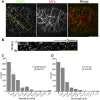





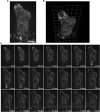


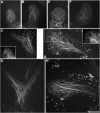
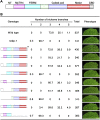
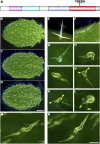


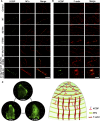



Similar articles
-
TCS1, a Microtubule-Binding Protein, Interacts with KCBP/ZWICHEL to Regulate Trichome Cell Shape in Arabidopsis thaliana.PLoS Genet. 2016 Oct 21;12(10):e1006266. doi: 10.1371/journal.pgen.1006266. eCollection 2016 Oct. PLoS Genet. 2016. PMID: 27768706 Free PMC article.
-
BEACH domain-containing protein SPIRRIG facilitates microtubule cytoskeleton-associated trichome morphogenesis in Arabidopsis.Planta. 2024 Oct 14;260(5):115. doi: 10.1007/s00425-024-04545-5. Planta. 2024. PMID: 39400709
-
TRANSPARENT TESTA GLABRA2 defines trichome cell shape by modulating actin cytoskeleton in Arabidopsis thaliana.Plant Physiol. 2024 May 31;195(2):1256-1276. doi: 10.1093/plphys/kiae091. Plant Physiol. 2024. PMID: 38391271
-
Molecular mechanisms controlling pavement cell shape in Arabidopsis leaves.Plant Cell Rep. 2009 Aug;28(8):1147-57. doi: 10.1007/s00299-009-0729-8. Epub 2009 Jun 16. Plant Cell Rep. 2009. PMID: 19529941 Review.
-
The role of the cytoskeleton and associated proteins in determination of the plant cell division plane.Plant J. 2013 Jul;75(2):258-69. doi: 10.1111/tpj.12177. Epub 2013 Apr 19. Plant J. 2013. PMID: 23496276 Review.
Cited by
-
Construction and validation of co-expression vector for rice alpha tubulin and microtubule associated protein respectively fused with fluorescent proteins.PeerJ. 2024 Sep 26;12:e18118. doi: 10.7717/peerj.18118. eCollection 2024. PeerJ. 2024. PMID: 39346063 Free PMC article.
-
Emerging roles of cortical microtubule-membrane interactions.J Plant Res. 2018 Jan;131(1):5-14. doi: 10.1007/s10265-017-0995-4. Epub 2017 Nov 23. J Plant Res. 2018. PMID: 29170834 Review.
-
Kinesin proteins HUG1 and HUG2 are essential for the formation and transportation of male germ units in Arabidopsis pollen tubes.Nat Plants. 2025 Aug;11(8):1489-1499. doi: 10.1038/s41477-025-02064-z. Epub 2025 Aug 4. Nat Plants. 2025. PMID: 40759770
-
Cell biology of primary cell wall synthesis in plants.Plant Cell. 2022 Jan 20;34(1):103-128. doi: 10.1093/plcell/koab249. Plant Cell. 2022. PMID: 34613413 Free PMC article. Review.
-
CORTICAL MICROTUBULE DISORDERING1 Is Required for Secondary Cell Wall Patterning in Xylem Vessels.Plant Cell. 2017 Dec;29(12):3123-3139. doi: 10.1105/tpc.17.00663. Epub 2017 Nov 13. Plant Cell. 2017. PMID: 29133465 Free PMC article.
References
-
- Basu D, Le J, El-Essal Sel D, Huang S, Zhang C, Mallery EL, Koliantz G, Staiger CJ, Szymanski DB. DISTORTED3/SCAR2 is a putative Arabidopsis WAVE complex subunit that activates the Arp2/3 complex and is required for epidermal morphogenesis. The Plant Cell. 2005;17:502–524. doi: 10.1105/tpc.104.027987. - DOI - PMC - PubMed
-
- Beilstein M, Szymanski D. In: Cytoskeletal requirements during Arabidopsis trichome development. The plant cytoskeleton in cell differentiation and development. Hussey P, editor. Blackwell: Hoboken, NJ, United States; p; 2004. pp. 265–289.
Publication types
MeSH terms
Substances
LinkOut - more resources
Full Text Sources
Molecular Biology Databases

